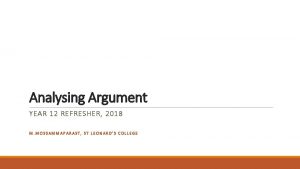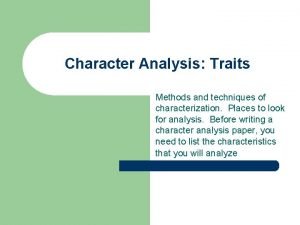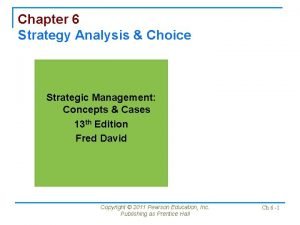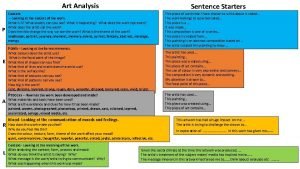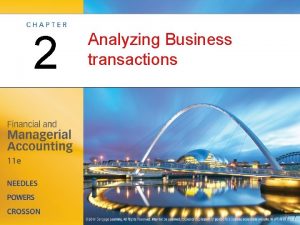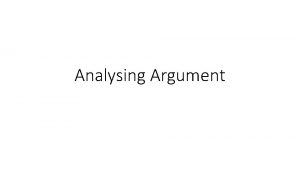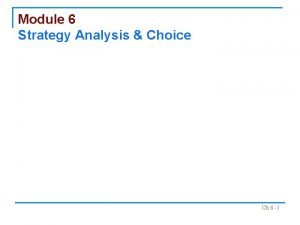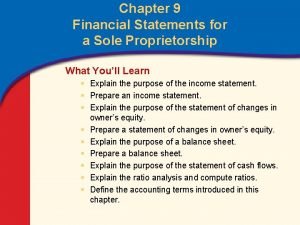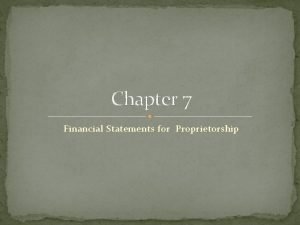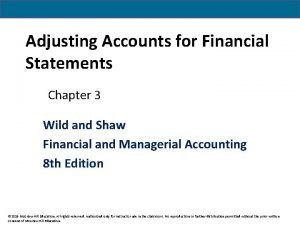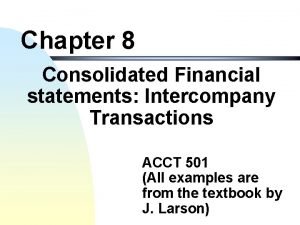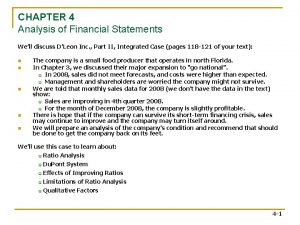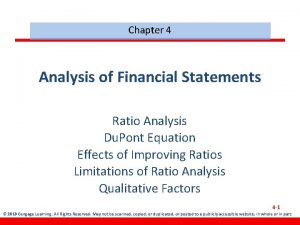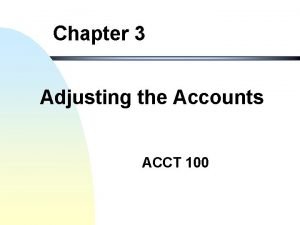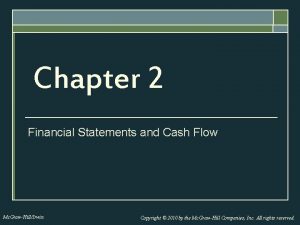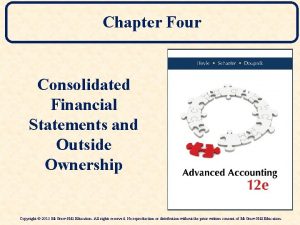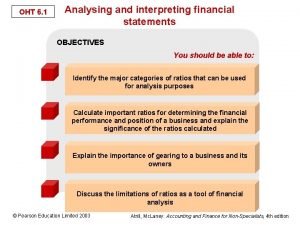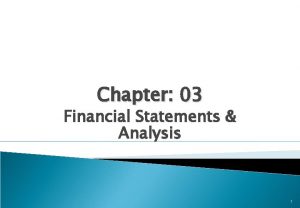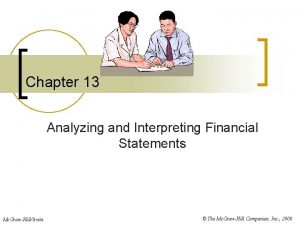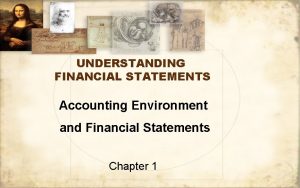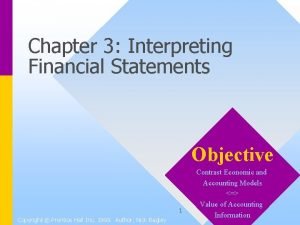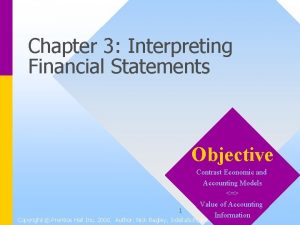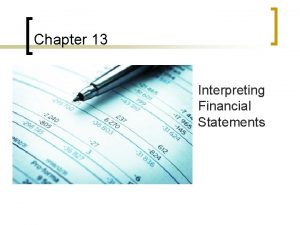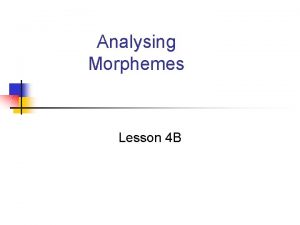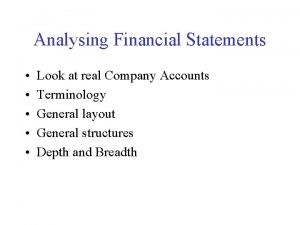Chapter 3 Analysing and interpreting financial statements Financial

































- Slides: 33

Chapter 3 Analysing and interpreting financial statements

Financial ratios • Provide a quick and relatively simple means of assessing the financial health of a business • Help to highlight the financial strengths and weaknesses of a business, but they cannot, by themselves, explain why those strengths or weaknesses exist or why certain changes have occurred. – Only a detailed investigation will reveal these underlying reasons • Can be expressed in various forms, for example as a percentage or as a proportion.

Financial ratio classifications • Profitability. • Businesses are concerned with creating wealth for their owners. • Profitability ratios – Provide an insight to the degree of success in achieving this purpose – Express the profit made (or figures bearing on profit, such as sales revenue or overheads) in relation to other key figures in the financial statements or to some business resource

Financial ratio classifications • Efficiency. • Be used to measure the efficiency with which particular resources have been used within the business • Be also referred to as activity ratios. • Liquidity. • Be vital to the survival of a business that there are sufficient liquid resources available to meet maturing obligations – Amounts owing that must be paid in the near future • Examine the relationship between liquid resources held and amounts due for payment in the near future

Financial ratio classifications • Financial gearing. • Be the relationship between the contribution to financing the business made by the owners of the business and the amount contributed by others, in the form of loans • The level of gearing has an important effect on the degree of risk associated with a business – Managers must consider when making financing decisions • Tend to highlight the extent to which the business uses borrowings

Financial ratio classifications • Investment. • Be concerned with assessing the returns and performance of shares in a particular business from the perspective of shareholders who are not involved with the management of the business

Financial ratio classifications • Shareholders • Be likely to be interested in their returns in relation to the level of risk associated with their investment – Profitability, investment and gearing • Long-term lenders • Be concerned with the long-term viability of the business – Profitability and gearing ratios of the business • Short-term lenders • Suppliers of goods and services on credit, may be interested in the ability of the business to repay the amounts owing in the short term – Liquidity ratios

The need for comparison • Past periods • By comparing the ratio with the same ratio for a previous period – Be possible to detect whethere has been an improvement or deterioration in performance. • Be often useful to track particular ratios over time (say, five or ten years) to see whether it is possible to detect trends • The comparison of ratios from different periods brings certain problems

The need for comparison • Trading conditions were quite different in the periods being compared • When comparing the performance of a single business over time, operating inefficiencies may not be clearly exposed • Inflation may have distorted the figures on which the ratios are based – Inflation can lead to an overstatement of profit and an understatement of asset values

The need for comparison • Similar businesses • A useful basis for comparing a particular ratio, is the ratio achieved by similar businesses during the same period • Problems – Different year ends – Different accounting policies – Be difficult to obtain the financial statements of competitor businesses

The need for comparison • Planned performance • Be compared with the targets that management developed before the start of the period under review • The comparison of planned performance with actual performance may therefore be a useful way of revealing the level of achievement attained

The need for comparison • Planned performance is likely to be the most valuable benchmark for the managers to assess their own business. • Businesses tend to develop planned ratios for each aspect of their activities. • When formulating its plans, a business may usefully take account of its own past performance and that of other businesses.

Balance sheets as at 31 March

Income statements for the year ended 31 March

Notes: • • The market value of the shares of the business at the end of the year was £ 2. 50 for 2007 and £ 1. 50 for 2008. All sales and purchases are made on credit. The cost of sales figure can be analysed as follows: A dividend of £ 40 m had been paid to the shareholders in respect of each of the years. The business employed 13, 995 staff at 31 March 2007 and 18, 623 at 31 March 2008. The business expanded its capacity during 2008 by setting up a new warehouse and distribution centre in the north of England. At 1 April 2006, the total of equity stood at £ 438 m and the total of equity and non-current liabilities stood at £ 638 m.

A brief overview • Expansion of non-current assets • Major expansion in the elements of working capital • Reduction in the cash balance • Apparent debt capacity • Lower operating profit

Profitability • • Return on ordinary shareholders’ funds Return on capital employed Operating profit margin Gross profit margin

Return on ordinary shareholders’ funds (ROSF) • Compares the amount of profit for the period available to the owners, with the owners’ average stake in the business during that same period

Return on capital employed (ROCE) • Fundamental measure of business performance

Operating profit margin

Gross profit margin • A measure of profitability in buying (or producing) and selling goods before any other expenses are taken into account

Profitability ratios

Gross Margin % & Return on Sales

Efficiency • Examine the ways in which various resources of the business are managed • Average inventories turnover period • Average settlement period for trade receivables • Average settlement period for trade payables • Sales revenue to capital employed • Sales revenue per employee

Average inventories turnover period

Average settlement period for trade receivables

Days to Sell Inventory & Avg. days to Collect Receivables

Average settlement period for trade payables

Sales revenue to capital employed • Asset turnover ratio – Examines how effectively the assets of the business are being used to generate sales revenue

Sales revenue per employee a measure of the productivity of the workforce

Efficiency, or activity, ratios

Relationship between profitability and efficiency • The main elements of the ROCE ratio

Alexis plc
 Inquiring and analysing
Inquiring and analysing Mountain bike mania running record
Mountain bike mania running record Analogy political cartoon
Analogy political cartoon Argument analysis structure
Argument analysis structure Analysing consumer market
Analysing consumer market The prohibited chow pest
The prohibited chow pest Method of characterization
Method of characterization Input stage in strategic management
Input stage in strategic management Sentence starters for art analysis
Sentence starters for art analysis How to analyse business transactions?
How to analyse business transactions? Strategy analysis and choice largely involves making
Strategy analysis and choice largely involves making Analysing argument
Analysing argument Analysing the 6 strategic options megxit
Analysing the 6 strategic options megxit Analysing market data
Analysing market data Chapter 03 financial analysis
Chapter 03 financial analysis Financial statements and ratio analysis chapter 3
Financial statements and ratio analysis chapter 3 Chapter 2 financial statements taxes and cash flow
Chapter 2 financial statements taxes and cash flow Chapter 3 adjusting accounts for financial statements
Chapter 3 adjusting accounts for financial statements Financial statement of sole proprietorship
Financial statement of sole proprietorship Sole proprietorship financial statements
Sole proprietorship financial statements Adjusting accounts for financial statements chapter 3
Adjusting accounts for financial statements chapter 3 Chapter 8 separate financial statements
Chapter 8 separate financial statements Chapter 4 analysis of financial statements
Chapter 4 analysis of financial statements Chapter 4 analysis of financial statements
Chapter 4 analysis of financial statements Working with financial statements chapter 3
Working with financial statements chapter 3 Adjusting the accounts chapter 3
Adjusting the accounts chapter 3 Adjusting entry accrued expense
Adjusting entry accrued expense Chapter 6:2 interpreting word parts
Chapter 6:2 interpreting word parts Chapter 6:2 using medical abbreviations
Chapter 6:2 using medical abbreviations Cash flow to creditors is equal to
Cash flow to creditors is equal to Unit 13 accounting and financial statements
Unit 13 accounting and financial statements Financial analysis for banks
Financial analysis for banks Consolidated financial statements and outside ownership
Consolidated financial statements and outside ownership Describing visual data
Describing visual data



